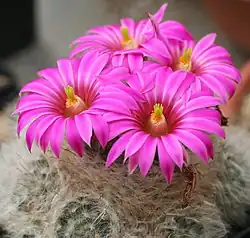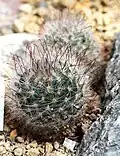Cochemiea guelzowiana
| Cochemiea guelzowiana | |
|---|---|

| |
| Scientific classification | |
| Kingdom: | Plantae |
| Clade: | Tracheophytes |
| Clade: | Angiosperms |
| Clade: | Eudicots |
| Order: | Caryophyllales |
| Family: | Cactaceae |
| Subfamily: | Cactoideae |
| Genus: | Cochemiea |
| Species: | C. guelzowiana
|
| Binomial name | |
| Cochemiea guelzowiana (Werderm.) P.B.Breslin & Majure
| |
| Synonyms | |
| |
Cochemiea guelzowiana is a species of plant belonging to the family Cactaceae.
Description
Cochemiea guelzowiana is a perennial plant that grows fleshy, globose, at first solitary and then forming groups. The stems have a spherical, apically depressed, about 7 inches tall and 4-10 inches in diameter. Tubercules are conical and cylindrical. They do not contain latex. The plant has 1-6 thin central spines, needle shaped, yellowish red, 8 to 25 millimeters long. The 60-80 radial spines are long and twisted, about 15 mm long. The bell-shaped flowers are purple, more or less bright, up to 4 inches long and can reach 7 inches in diameter. The fruits are almost spherical, bright red or yellowish white, about 8 mm in length.[2]
-
Cochemiea guelzowiana at the Orto Botanico dell'Università di Genova
-
 Cochemiea guelzowiana at the Prague Botanic Garden
Cochemiea guelzowiana at the Prague Botanic Garden -
.jpg) Flowers
Flowers
Distribution
This species is endemic to Mexico where it grows west of Nazas and north of Navidad Mine in Indé Municipality, Durango; Coahuila; and Nuevo León. Its natural habitat are hot deserts and grassy mountain tops on rocky outcrops at elevations of 1,300–1,700 metres (4,300–5,600 ft) above sea level. Plants are found growing along Thelocactus bicolor subsp. heterochromus, Coryphantha longicornis, Stenocactus multicostatus, Echinocereus polyacanthus, Echinocereus pectinatus, Fouquieria splendens, and Cylindropuntia imbricata.[3]
-
.jpg) Habitat in Rio Nazas, Durango
Habitat in Rio Nazas, Durango -
.jpg) Plant growing in rock outcrop in Rio Nazas, Durango
Plant growing in rock outcrop in Rio Nazas, Durango -
.jpg) Closeup of plant growing in rock outcrop
Closeup of plant growing in rock outcrop
Taxonomy
This species was first described as Mammillaria guelzowiana and published in 1928 by the German botanist Erich Werdermann in the scientific journal Zeitschrift für Sukkulentenkunde 3: 356. The species epithet guelzowiana honors the German cactus collector Robert Gülzow of Berlín. Botanists Peter B. Breslin and Lucas C. Majure placed the species in the genus Cochemiea in the scientific journal Taxon 70: 319 in 2021.[4]
References
- ^ Fitz Maurice, W.A.; Fitz Maurice, B (2017). "Mammillaria guelzowiana". IUCN Red List of Threatened Species. 2017: e.T40836A121499961. doi:10.2305/IUCN.UK.2017-3.RLTS.T40836A121499961.en. Retrieved 17 November 2021.
- ^ Anderson, Edward F.; Eggli, Urs (2005). Das grosse Kakteen-Lexikon (in German). Stuttgart (Hohenheim): Ulmer. p. 384. ISBN 3-8001-4573-1.
- ^ Vallicelli, Valentino (2013-08-04). "Mammillaria guelzowiana". LLIFLE. Retrieved 2024-05-04.
- ^ "Mammillaria guelzowiana Werderm". Plants of the World Online. Retrieved 2025-08-04.
- Tropicos
- The plant list
- Cacti Guide
- Mammillaria.net
- Urs Eggli, Leonard E. Newton: Etymological Dictionary of Succulent Plant Names. Birkhäuser 2004
External links
 Media related to Cochemiea guelzowiana at Wikimedia Commons
Media related to Cochemiea guelzowiana at Wikimedia Commons Data related to Cochemiea guelzowiana at Wikispecies
Data related to Cochemiea guelzowiana at Wikispecies
